|
TIMBRE, MUSICAL INSTRUMENTS
| TIMBRE |
 |
|
 |
Pronounced
"tambour" it means: The tone quality or the unique
characteristic of a tone. Another word(s) for timbre is tone
color. The timbre of a note produced on an instrument or sung
by the human voice is determined in part by the size, design
and make up of the instrument or vocal chords, what is being
vibrated and by the way the sound is produced. Others considerations
that influence the timbre of an instrument is what the instrument
is made of. Wood vibrating has a different sound than air
within a brass chamber vibrating. In addition a stretched
skin vibrating over a resonating chamber produces yet another
timbre. Dark, bright, nasal, sweet, natural, smooth, full,
thin, sharp, dull, mellow, round, full bodied and warm are
just some of the adjectives used to describe the timbre or
tone quality of an instrument or singing voice.
| MUSICAL
INSTRUMENTS |
 |
|
 |
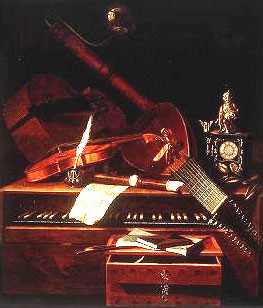 |
 |
Still
Life with Musical Instruments
Pieter
Van Roestraten (1630 - 1700 London) Gemeentemuseum, The
Hague |
When
one thinks of timbre one thinks of an instrument or voice
producing sound. Once an instrument produces sound and the
sound waves are carried through the air, the listener hears
the sound and turns it into something meaningful. The types
and kinds of musical instruments of the world are many and
varied. In Western Classical music there are six categories
and at least four instruments from each. Most of the instruments
from the following categories cover the range from high to
low SATB (soprano, alto, tenor, bass):
 |
 |
Strings |
 |
|
Woodwinds |
 |
|
Brass |
 |
|
Percussion |
 |
|
Plucked
Strings |
 |
|
Keyboard |
| STRINGS |
 |
|
 |
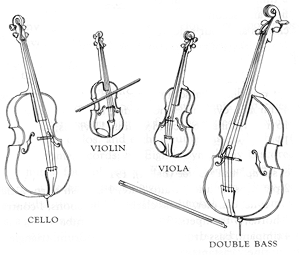
Instruments
on which tones are produced by the vibrations of tightly stretched
strings. The strings are long-drawn-out across a wooden resonator
to increase the volume. When playing string instruments they
can be either bowed, plucked or strummed. In western music
the term “strings” refers to the bowed instruments
of the symphony orchestra. From high to low they are:
 |
 |
Violin |
 |
|
Viola |
 |
|
Cello
(violoncello) |
 |
|
Double
Basssans |
| VIOLIN |
 |
|
 |
 |
 |
"Violin
(or fiddle): An instrument to tickle human ears by friction
of a horse's tail on the entrails of a cat."
Ambrose
Bierce, 1911 |
The
highest pitched member of the bowed string family. It consists
of a wooden body in an outline of a figure eight. With f shape
sound holes, the length of the violin was determined by the
average length of the human arm from the shoulder to the palm
of the hand. More solo and orchestra works in the classical
literature have been written for the violin then any other
instrument. The 4 strings were originally made of pig gut
or sheep intestine, today the are metal or less common nylon.
The bow which helps grab the strings while they are being
played is made of a wooden stick strung end to end with horse
hair. Resin is applied to help grip the hair of the bow onto
the violin string. The notes are produced by drawing the bow
across the strings. The right hand holds the bow while the
left hand holds the strings down by placing it on the fingerboard
to effectively shorten the string length and make the notes
higher.
The
alto or midrange member of the string family of instruments.
It is longer and larger than the violin and it is tuned a
fifth lower than the violin (5 scale steps). Because it is
longer it is often said that an ideal violist should have
long arms. The viola produces a thicker and perhaps warmer
tone than it’s brighter sibling the violin. Violists
play most often in middle parts as accompaniment. As a result
they are often very kind and friendly people. (joke! but sometimes
true).
| CELLO |
 |
|
 |
|
 |
 |
The greatest cellist of all time and some feel
the finest musician alive today is Yo-Yo Ma. His
easy going, nice and profound personality is perhaps
largely due to the fact that he plays one of the
worlds most beautifully rich instruments.
|
The
tenor of the string family. Much larger than the violin
or viola. So large that it’s performer sits with the
cello resting on his or her knees. A spike at the end of
the cello supports the instrument from the floor up. Having
the same proportions as the violin and viola the larger
cello requires a greater stretch of the left hand fingers
but it can still play arpeggios, chords, scales, etc. The
cello is noted for its lush, vocal like qualities and consequently
has some of classical music’s most expressive pieces
are written for it. It’s nick name “violoncello”
means “little bass viol or small double bass.”
| DOUBLE
BASS |
 |
|
 |
|
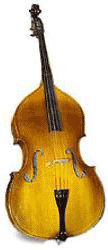 |
 |
“The
lewd trebles speak nothing but bawdy, and the basses
roar blasphemy.”
The
Way of the World, 1700.
{trebles
(high strings), bawdy (rudeness), blasphemy (wickedness)}
|
The
lowest of the string instrument family. Known also as the
“bass” (pronounced “base”) or the “bull
fiddle.” Because of it’s low register the double
bass almost never plays the main theme in a symphony orchestra
setting but instead provides the foundation for an orchestras
tone. An average height of a double bass is six feet tall
and the bass player has to stand or sit on a high stool while
playing. The strings of a double bass are very thick and the
hands of a player must be large and strong to play it comfortably.
|
|
|
|
| WOODWINDS |
 |
|
 |
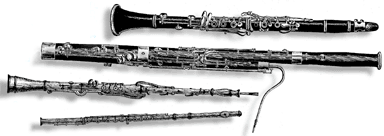
 |
 |
Clarinet
|
 |
|
Bassoon
|
 |
|
Oboe
|
 |
|
Flute
|
The
woodwinds are so called because they all used to be made of
wood. In past times, especially during the Baroque period
(1600-17500), the woodwinds were all wooden but today the
flute, piccolo and saxophone are made of metal. In addition
most woodwinds have a single or double reed. A reed is a very
thin piece of bamboo, which vibrates against the mouthpiece
of instrument. The clarinet and saxophone are single reed
instruments (one piece of cane) and the oboe is a double reed
instrument (two pieces of cane vibrating against itself).
| FLUTE |
 |
|
 |
|
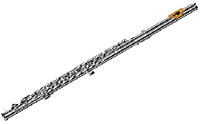 |
 |
"Tom,
Tom, the piper’s son,
He learned to play when he was young,
But all the tune that he could play,
Was “Over the Hills and Far Away.”
Nursery
rhyme, c. 1650
|
The
high voice of the woodwind family but not the highest. The
flute player holds the instrument sideways and blows air across
the mouth piece. The tone is produced similar to when one
blows across the top of a bottle. Flutes used to be made of
wood but a modern flute today is usually made of silver and
sometimes even gold. Flutes date back to ancient time when
stone age man would make whistles from bone, clay or wood.
The earliest flutes didn’t have any openings or finger
holes. Once holes or openings bored into the flute’s
side were added, a wider number of tones were possible to
create melodies.The piccolo (or small flute) is the highest
pitched instrument of the woodwinds and the highest instrument
of the orchestra. It is an octave higher than the flute and
produces a penetrating and shrill sound which adds brilliants
to top end of an orchestras sound.There is a countrified feeling
(pastoral feeling) conveyed in the sound of the flute. Composers
have used it to invoke a feeling of loneliness which is often
experienced by shepherds who use flutes to pacify time while
tending sheep in the country side.
| OBOE |
 |
|
 |
|
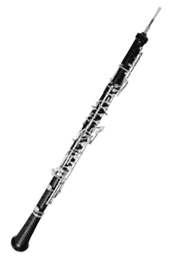 |
 |
“That
noise or sound which musicians make while they are
tuning their instruments (to the oboe), is nothing
pleasant to hear, but yet is a cause why the music
is sweeter afterwards.”
Francis
Bacon (1561-1626)
|
The
most expressive of the woodwinds the oboe’s tone is produced
by a player exhaling into two thin strips of reed (double
reed). Oboists spend much of their time making and shaping
their reeds. The thinner and narrower the reed the more agreeable
the sound. The oboe produces a sharp twang or nasal sound
but composers have used the oboe for some of the symphonic
repertoire’s most expressive writing. Popular in Egypt,
Greece and Turkey the early oboe (aulos or shawm) was the
instrument that could make a snake dance out of a basket.
Because of it’s position in the orchestra and it’s
pointed tone, it is the oboe in today’s orchestra that
gives the pitch “A” for all the instruments to tune
to.
| CLARINET |
 |
|
 |
|
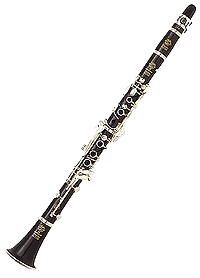 |
 |
“The
clarinet is suited to the expression of sorrow, and
even when it plays a merry air there is a suggestion
of sadness about it. If I were to dance in a prison,
I should wish to do so to the accompaniment of a clarinet.”
Andre Gretry, Memoirs
|
The
single reed member of the woodwind family. This means one
piece of heavy cane is made to flutter against the mouth piece
of the players clarinet. The clarinet has a fairly narrow
body (not as narrow as the oboe), a tube about two feet long
and seven holes bored into it’s side. As the single reed
vibrates at the mouth piece, the players breath travels through
the clarinet and comes out at the other end which is called
the bell. The clarinet was invented in 1675 by Johan Denner
of Nuremberg, Germany and is typically made of ebony an extremely
hard, black wood.The clarinet has a richly expressive range
of dynamics from a hushed piano to a swelled crescendo. It
blends well with the strings and has a very mellow smooth
sound. Also it is able to freely play fast passages of scales
and arpeggios in low and high registers. The clarinet is most
often used in the symphony orchestra and was a favorite instrument
of Mozart’s during its early invention. But one also
frequently hears the clarinet in a jazz and dance band settings
were squealing, laughing tones are not uncommon.
| BASSOON |
 |
|
 |
|
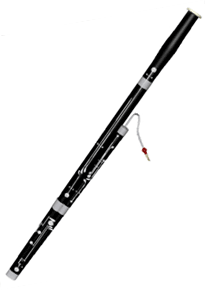 |
 |
"Tempestuous
clarion, with heavy cry,
Came bluntly thundering, more terrible,
Than the revenge of music on bassoons."
Wallace
Stevens, 1924
|
The
bass of the woodwind family. The bassoon’s tube has a
length of over eight feet and in the lowest register it has
a heavy dark tone. The bassoon often plays amusing and humorous
music and is sometimes referred to as the “clown of the
orchestra.;” but it can also play serious, beautiful
music including concertos. Like an oboe but much larger, the
bassoon is a double reed instrument. It was invented in 1650
and a player must have large hands to comfortably control
the finger holes the instrument. The rich sound of the bassoon
takes on the character of grandfather in Prokofiev’s
famous Peter and the Wolf.
|


